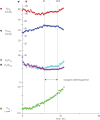Minute ventilation/carbon dioxide production in chronic heart failure
- PMID: 33536259
- PMCID: PMC9489123
- DOI: 10.1183/16000617.0141-2020
Minute ventilation/carbon dioxide production in chronic heart failure
Abstract
In chronic heart failure, minute ventilation (V'E) for a given carbon dioxide production (V'CO2 ) might be abnormally high during exercise due to increased dead space ventilation, lung stiffness, chemo- and metaboreflex sensitivity, early metabolic acidosis and abnormal pulmonary haemodynamics. The V'E versus V'CO2 relationship, analysed either as ratio or as slope, enables us to evaluate the causes and entity of the V'E/perfusion mismatch. Moreover, the V'E axis intercept, i.e. when V'CO2 is extrapolated to 0, embeds information on exercise-induced dead space changes, while the analysis of end-tidal and arterial CO2 pressures provides knowledge about reflex activities. The V'E versus V'CO2 relationship has a relevant prognostic power either alone or, better, when included within prognostic scores. The V'E versus V'CO2 slope is reported as an absolute number with a recognised cut-off prognostic value of 35, except for specific diseases such as hypertrophic cardiomyopathy and idiopathic cardiomyopathy, where a lower cut-off has been suggested. However, nowadays, it is more appropriate to report V'E versus V'CO2 slope as percentage of the predicted value, due to age and gender interferences. Relevant attention is needed in V'E versus V'CO2 analysis in the presence of heart failure comorbidities. Finally, V'E versus V'CO2 abnormalities are relevant targets for treatment in heart failure.
Copyright ©ERS 2021.
Conflict of interest statement
Conflict of interest: P. Agostoni reports non-financial support from Menarini, grants from Daiichi Sankyo and Bayer; non-financial support from Novartis and Boehringer; and grants and non-financial support from Actelion, outside the submitted work. Conflict of interest: S. Sciomer has nothing to disclose. Conflict of interest: P. Palermo reports personal fees from Novartis and Malesci, outside the submitted work. Conflict of interest: M. Contini reports personal fees and non-financial support from Dompé Farmaceutici S.p.A. and personal fees from Novartis, outside the submitted work. Conflict of interest: B. Pezzuto has nothing to disclose. Conflict of interest: S. Farina has nothing to disclose. Conflict of interest: A. Magini has nothing to disclose. Conflict of interest: F. De Martino has nothing to disclose. Conflict of interest: D. Magrì has nothing to disclose. Conflict of interest: S. Paolillo has nothing to disclose. Conflict of interest: G. Cattadori has nothing to disclose. Conflict of interest: C. Vignati has nothing to disclose. Conflict of interest: M. Mapelli has nothing to disclose. Conflict of interest: A. Apostolo has nothing to disclose. Conflict of interest: E. Salvioni has nothing to disclose.
Figures






Comment in
- doi: 10.1183/16000617.0244-2020
Similar articles
-
Ventilation/carbon dioxide output relationships during exercise in health.Eur Respir Rev. 2021 Apr 13;30(160):200160. doi: 10.1183/16000617.0160-2020. Print 2021 Jun 30. Eur Respir Rev. 2021. PMID: 33853883 Free PMC article.
-
Minute ventilation to carbon dioxide output (V'E/V'CO2 slope) is the strongest death predictor before larger lung resections.Monaldi Arch Chest Dis. 2017 Sep 22;87(3):817. doi: 10.4081/monaldi.2017.817. Monaldi Arch Chest Dis. 2017. PMID: 29424191
-
Exertional ventilation/carbon dioxide output relationship in COPD: from physiological mechanisms to clinical applications.Eur Respir Rev. 2021 Sep 15;30(161):200190. doi: 10.1183/16000617.0190-2020. Print 2021 Sep 30. Eur Respir Rev. 2021. PMID: 34526312 Free PMC article. Review.
-
Ventilatory response to exercise in cardiopulmonary disease: the role of chemosensitivity and dead space.Eur Respir J. 2018 Feb 7;51(2):1700860. doi: 10.1183/13993003.00860-2017. Print 2018 Feb. Eur Respir J. 2018. PMID: 29437936 Review.
-
Physiological and clinical relevance of exercise ventilatory efficiency in COPD.Eur Respir J. 2017 Mar 8;49(3):1602036. doi: 10.1183/13993003.02036-2016. Print 2017 Mar. Eur Respir J. 2017. PMID: 28275174 Review.
Cited by
-
Identification of Non-Invasive Exercise Thresholds: Methods, Strategies, and an Online App.Sports Med. 2022 Feb;52(2):237-255. doi: 10.1007/s40279-021-01581-z. Epub 2021 Oct 25. Sports Med. 2022. PMID: 34694596 Review.
-
It's Time to Run!J Clin Med. 2023 Sep 4;12(17):5758. doi: 10.3390/jcm12175758. J Clin Med. 2023. PMID: 37685825 Free PMC article.
References
MeSH terms
Substances
LinkOut - more resources
Full Text Sources
Other Literature Sources
Medical
